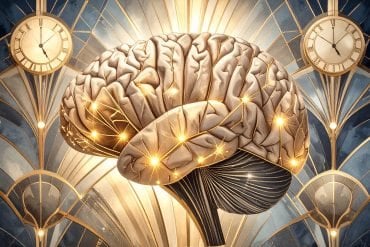Summary: Administering oxytocin via nasal spray to new mothers strengthened their brain responses to images of baby and adult faces, researchers report.
Source: University of Tampere.
In a new study from the University of Tampere in Finland, nasally administered oxytocin spray strengthened brain responses to pictures of infant and adult faces in mothers of 1-year-old infants.
Oxytocin is a hormone and a neuropeptide that has an important role in inducing labor, lactation, and caregiving behaviors in mammals. The influence of oxytocin on the perception of faces, emotions, and other social information has been widely studied in recent years by administering oxytocin with a nasal spray. Studies have shown, for example, that intranasal oxytocin administration may increase emotion recognition and brain activity during face perception.
Oxytocin appears to have an important role in processing social information and maintaining social bonds. Considering that some researchers have even suggested that in the future oxytocin might be used to overcome problems in early parent-infant interaction, there have been surprisingly few studies that test the effects of intranasal oxytocin in mothers of young children.
The new study investigated whether oxytocin nasal spray has an effect on the neural responses to faces in mothers of 1-year-old infants. Given the role of oxytocin in early caregiving behaviors, the specific goal of the study was to explore whether the effects of oxytocin are more pronounced in response to infant faces. Brain responses were measured with electroencephalography (EEG) which provides information on the early stages of visual perception.
The participants were 52 Finnish mothers of 1-year-old infants. During two laboratory visits, the researchers used EEG to measure the mothers’ neural responses to infant and adult faces. Before each measurement, the mothers were administered either a placebo or an oxytocin nasal spray. A double-blind study design was used so that neither the mothers nor the researchers knew which spray was administered.

The analysis showed that oxytocin increased the so-called N170 component of the EEG signal in response to infant and adult faces. The N170 component reflects activation of brain areas sensitive to faces, indicating that faces activated these areas more strongly after being administered oxytocin. The results did not clearly show whether the effects of oxytocin were larger in response to infant faces than to adult faces.
“The main contribution of this study was to expand experimental oxytocin research to the mothers of young children who have rarely been included in this type of studies,” says Academy Research Fellow Mikko Peltola from the University of Tampere.
“In the future, it will be important to conduct research with larger samples in order to determine whether oxytocin specifically affects sensitivity to infant signals because that is one of the key aspects of parenting,” says Professor Kaija Puura from the University of Tampere and Tampere University Hospital.
Funding: The research was funded by the Academy of Finland and included collaboration between the University of Tampere, Tampere University Hospital, and the University of Iowa.
Source: Mikko Peltola – University of Tampere
Publisher: Organized by NeuroscienceNews.com.
Image Source: NeuroscienceNews.com image in credited to Cardel et al/Psychoneuroendocrinology.
Original Research: Open access research in Psychoneuroendocrinology.
doi:10.1016/j.psyneuen.2018.02.012
[cbtabs][cbtab title=”MLA”]University of Tampere “Oxytocin Strengthens Mother’s Neural Responses to Infant and Adult Faces.” NeuroscienceNews. NeuroscienceNews, 26 February 2018.
<https://neurosciencenews.com/oxytocin-facial-response-8560/>.[/cbtab][cbtab title=”APA”]University of Tampere (2018, February 26). Oxytocin Strengthens Mother’s Neural Responses to Infant and Adult Faces. NeuroscienceNews. Retrieved February 26, 2018 from https://neurosciencenews.com/oxytocin-facial-response-8560/[/cbtab][cbtab title=”Chicago”]University of Tampere “Oxytocin Strengthens Mother’s Neural Responses to Infant and Adult Faces.” https://neurosciencenews.com/oxytocin-facial-response-8560/ (accessed February 26, 2018).[/cbtab][/cbtabs]
Abstract
Oxytocin promotes face-sensitive neural responses to infant and adult faces in mothers
Research utilizing intranasal oxytocin (OT) administration has shown that OT may increase attention and sensitivity to social cues, such as faces. Given the pivotal role of OT in parental behaviors across mammals, the paucity of intranasal OT research investigating responses to social cues in parents and particularly mothers of young children is a critical limitation. In the current study, we recorded cortical event-related potentials (ERPs) to investigate whether intranasal OT affects the early neural responses to emotional faces in mothers of 1-year-old infants. Using a double-blind, within-subjects design, mothers (n = 38) were administered intranasal OT and placebo on separate sessions and presented with happy and sad infant and adult faces while ERP components reflecting face-sensitive brain activation and attention allocation were measured. We hypothesized that ERP responses to faces would be larger in the OT condition and that the effects of OT on ERP responses would be more pronounced for infant faces. The amplitudes of the face-sensitive N170 ERP component were larger in the OT condition to infant and adult faces, but no clear support was found for the hypothesis that the responses to infant faces would be more susceptible to OT effects than the responses to adult faces. The attention-sensitive late positive potential (LPP) component was not modulated by intranasal substance condition. The results are in line with the view that OT acts to enhance the perceptual salience of social and emotional stimuli. Demonstrating such effects in mothers of young children encourages further investigation of the potential of intranasal OT to affect the perception of social cues relevant for parent-child interaction.






